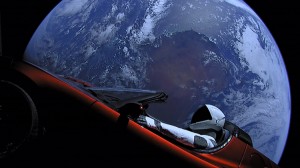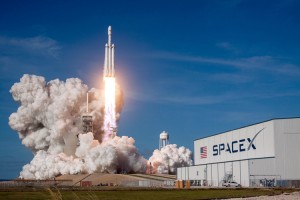The Mighty Falcon Heavy
Tuesday, February 20th, 2018February 20, 2018
When people want to get rid of an old car, they might trade it in for credit toward a new one, tow it to a junkyard, or donate to charity. South Africa-born entrepreneur (business developer) Elon Musk took a different route with his old Tesla Roadster: he launched it into space. Musk’s Space Exploration Technologies Corporation (commonly called SpaceX), sent the car into an elliptical (oval-shaped) orbit around the sun, traveling as far out as the main asteroid belt. The whimsical cargo was, in fact, part of an important mission. It was the test payload for SpaceX’s first launch of the company’s new rocket: the Falcon Heavy.
SpaceX launched the Falcon Heavy on February 6 from Kennedy Space Center in Florida. It was the most powerful rocket launch since those of the United States space shuttle program. The rocket uses three modified cores from SpaceX’s workhorse rocket, the Falcon 9.

The Falcon Heavy launched into space a Tesla Roadster, seen here with Earth in the background, piloted by a dummy driver named “Starman.” Credit: SpaceX
SpaceX has succeeded in bringing launch costs down by landing and reusing its boosters, something no other company or space agency has been able to do. (The U.S. space shuttle program featured partly reusable components, but they required extensive repair and refurbishment after each flight.) The two side boosters were “flight-proven” Falcon 9 boosters from previous missions, having landed back on Earth near the launch pad or on one of the company’s drone ships (uncrewed barges) at sea. In the February 6 launch, the side boosters shot into the upper atmosphere, broke away, and then returned to Earth in a spectacular tandem landing. The center booster attempted to land on a drone ship in the Atlantic Ocean, but the rocket engines misfired during its descent, sending the booster to its doom a short distance from the landing barge.
Apart from the failure of the center booster, the test of the Falcon Heavy represented an amazing success for SpaceX. The mighty rocket may not have much of a future, however, as engineers at SpaceX have almost tripled the payloads and power of individual Falcon 9′s. These developments have reduced demand for the Falcon Heavy because many heavier satellites can now shoot into space aboard proven Falcon 9’s.
SpaceX has also scaled back plans for crewed missions aboard the Falcon Heavy. Instead, the company will focus on flying astronauts to the International Space Station (ISS) with Falcon 9′s and concentrate on the development of an even bigger booster rocket, the Big Falcon Rocket. To generate revenue, however, SpaceX is considering flying astronauts or even space tourists aboard the Falcon Heavy.
The U.S. National Aeronautics and Space Administration (NASA) is creating its own large rocket, the single-use Space Launch System (SLS), to send probes deep into the solar system and to take astronauts to the moon and Mars aboard the Orion capsule (which is also under development). The SLS is being built largely at the same facilities used to create parts for the old space shuttle program (which ended in 2011). Because these manufacturing plants are scattered across the country and employ thousands of people, the U.S. Congress has a strong desire to continue the SLS project, despite its high cost and limited potential usefulness.
The SLS and Orion projects are both facing huge delays and budget overruns. The first SLS test flight will not occur until at least 2020, and each mission will likely cost more than $1 billion. A Falcon Heavy launch is priced at just $90 million. Under such circumstances, NASA may well rely on SpaceX’s Falcon Heavy to launch probes to other planets, or even to return astronauts to the moon.
Falcon Heavy’s next launch will be in June 2018—a test for the U.S. Air Force. If successful, this test launch could pave the way for further Falcon Heavy launches for the military. SpaceX continues its ambitious goal of bringing down the cost of space transport, but it remains to be seen how big a part the Falcon Heavy will play.



